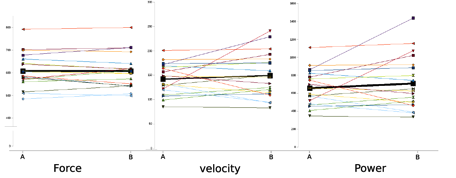Shaving may be a daily ritual for most men, but for athletes it is much more open to debate. Some athletes shave with a vengeance : cyclists shave their legs by tradition and to make easier cleaning road rash and massages, swimmers may even shave their entire body (particularly before swimming suits were authorized) to minimize friction, and body builders go for a full body shave for aesthetic reasons (1). Conversely, in boxing, rugby and other sports where high power production is required, many athletes prefer to wait till after the competition before shaving. They do that to avoid any negative effect of shaving on explosive strength (2). Although to our knowledge there is no scientific rationale for this commonplace idea, shaving one’s beard just before a physical performance is said to impair the nervous flux involved in force production (2). This assumption may be linked to the fate of Samson in the Old Testament, who was reported to loose his strength after having his hair cut (3). This possible decrease in muscle force following beard shaving has been largely feared for Sebastien “Caveman” Chabal, a popular rugby player during the 2007 Rugby World cup who sported a long mane and a thick beard. The player did not risk the strength loss and kept his hair and his beard for the following sport seasons. Although science provides advances for a better understanding of sport performance, many commonplace ideas endure in athletes population (4,5). The fear of ending up weakened like Samson still remains widespread and has not been investigated scientifically, to our knowledge, which motivated the present study. We focused on peak power which can be determined from the force-velocity relationship and is an important functional property from a physical performance perspective. Twenty university students (23.4 ± years; 177.6 cm and 74.2 kg), all trained athletes, were included during bench press tests. There were studied in two cross-over sessions undertaken in a random order, assessing force, velocity and power peaks. One session was with beard shaving 2 to 3 hours prior to the test, and the other was with no beard shaving in the preceding 36 hours. After several warm-up sets using light weights of their choice, subjects performed five consecutive bench press lifts (load corresponding to 50-70 % of their own one-repetition maximum ) with pushes at the highest possible velocity. Lifts were performed using an Olympic bar and plates equipped with an inertial dynamometer using accelerometry (Myotest S.A., Switzerland) reported as a valid and reliable method to assess maximal force, velocity and power from loads corresponding to 30-70% of the one-repetition maximum (6). Analysis of variance for repeated measurements were used to detect differences between the sessions. Results from bench press tests described an homogeneous group of subjects trained in this particular movement of strength training with unchanged performances between the first and second tests (P=0.43).
Figure 1 : Peaks for force, velocity and power in subjects not shaved (A) and recently shaved (B). Means are in bold black lines, forces are expressed in N, velocity in cm/s, power in W.
The performances in maximal power, velocity and force appeared unchanged by the shaving status (P=0.39). Beard shaving shortly before exercise did not appear to affect muscle force production although our results did not assess a possible influence on nervous flux. Our results suggest that the “Samson negative effect” of beard shaving is truly a myth. However, modifying their routine and beliefs could influence their psychological disposition for optimal performance, and change the image they want to project. Therefore, athletes may not be shaved before competing, but from now on they should invoke a better reason than optimization of force production.
Desgorces FD, Trémion M, Noirez P
Université Paris Descartes, UFR STAPS, Paris, France
References
1 R.L. Sharp, D.L. Costill, Med Sci Sports Exerc 21,576-80 (1989)
2 A. Saouter, Terrain n°25, revue d’ethnologie de l’europe, Eds (French culture ministry and foundation of Paris home of Human sciences, Paris 1995).
3 The Old Testament, Book of Judges 16
4 N. Yang, D.G. MacArthur, J.P. Gulbin, A.G. Hahn, A.H. Beggs, S. Easteal, K. North, Am J Hum Genet 73,627-31 (2003)
5 F.D. Desgorces, G. Berthelot, N. El Helou, V. Thibault, M. Guillaume, M. Tafflet, O. Hermine, J.F. Toussaint, PLoS One 3, e3653 (2008)
6 B. Jidovtseff, J.M. Crielaard, S. Cauchy, J.L. Croisier, Sci Sports 23, 94-97 (2008)
